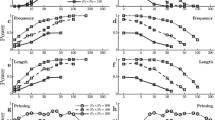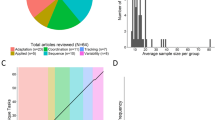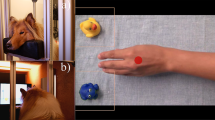Abstract
Making correct inferences regarding social and individual intentions may be crucial for successful interactions, especially when we are required to discriminate between cooperative and competitive behaviors. The results of previous studies indicate that reach-to-grasp kinematic parameters may be used to infer the social or individual outcome of a movement. However, the majority of the studies investigated this ability by presenting reach-to-grasp movements from a third-person perspective only. The aim of the present study was to assess whether the ability to recognize the intent associated to a reach-to-grasp movement varies as a function of perspective by manipulating the perspective of observation (second- and third-perspective) within participants. To this end, we presented participants with video clips of models performing a reach-to-grasp movement with different intents. The video clips were recorded both from a lateral view (third-person perspective) and from a frontal view (second-person perspective). After viewing the clips, in two subsequent tasks participants were asked to distinguish between social and non-social intentions by observing the initial phase of the same action recorded from the two different views. Results showed that, when a fast-speed movement was presented from a lateral view, participants were able to predict its social intention. In contrast, when the same movement was observed from a frontal view, performance was impaired. These results indicate that the ability to detect social intentions from motor cues can be biased by the visual perspective of the observer, specifically for fast-speed movements.



Similar content being viewed by others
Notes
To avoid misunderstanding and in line with Sartori, Becchio and Castiello (2011), with the term “social intention” we referred to an action intention that involves other agents (i.e., to grasp an object and move it to give it to somebody). In contrast, with the term “motor intention” we referred to the general goal of an action (i.e., to grasp and move an object from one position to another).
The criterion c reflects a general tendency to use one of the two response keys, thus a value of 0 indicates neutral bias.
A value of 0 indicates an inability to distinguish signal from no signal, whereas larger values indicate a correspondingly greater ability to distinguish signal from noise.
References
Ansuini, C., Cavallo, A., Koul, A., D’Ausilio, A., Taverna, L., & Becchio, C. (2016). Grasping others’ movements: Rapid discrimination of object size from observed hand movements. Journal of Experimental Psychology: Human Perception and Performance, 42(7), 918–929. doi:10.1037/xhp0000169.
Ansuini, C., Santello, M., Massaccesi, S., & Castiello, U. (2006). Effects of end-goal on hand shaping. Journal of Neurophysiology, 95, 2456–2465. doi:10.1152/jn.01107.2005.
Ansuini, C., Giosa, L., Turella, L., Altoè, G. M., & Castiello U. (2008). An object for an action, the same object for other actions: effects on hand shaping. Experimental Brain Research, 185, 111–119. doi:10.1007/s00221-007-1136-4.
Becchio, C., Sartori, L., Bulgheroni, M., & Castiello, U. (2008a). The case of Dr. Jekyll and Mr. Hyde: A kinematic study on social intention. Consciousness and Cognition, 17, 557–564. doi:10.1016/j.concog.2007.03.003.
Becchio, C., Sartori, L., Bulgheroni, M., & Castiello, U. (2008b). Both your intention and mine are reflected in the kinematics of my reach to grasp movement. Cognition, 106, 894–912. doi:10.1016/j.cognition.2007.05.004.
Böckler, A., van der Wel, R. P., Welsh, T. N. (2014). Catching eyes effects of social and nonsocial cues on attention capture. Psychological Science, 25, 720–727. doi:10.1177/0956797613516147
Cattaneo, L., Fabbri-Destro, M., Boria, S., Pieraccini, C., Monti, A., Cossu, G., & Rizzolatti, G. (2007). Impairment of actions chains in autism and its possible role in intention understanding. Proceedings of the National Academy of Sciences, 104(45), 17825–17830. doi:10.1073/pnas.0706273104.
Ciardo, F., Ricciardelli, P., Lugli, L., Rubichi, S., & Iani, C. (2015). Eyes keep watch over you! Competition enhances joint attention in females. Acta Psychologica, 160, 170–177. doi:10.1016/j.actpsy.2015.07.013.
De Jaegher, H., & Di Paolo, E. (2007). Participatory sense-making: An enactive approach to social cognition. Phenomenology and the Cognitive Sciences, 6(4), 485–507.
De Jaegher, H., Di Paolo, E., & Gallagher, S. (2010). Can social interaction constitute social cognition? Trends in cognitive sciences, 14(10), 441–447. doi:10.1016/j.tics.2010.06.009.
Decety, J., Jackson, P. L., Sommerville, J. A., Chaminade, T., & Meltzoff, A. N. (2004). The neural bases of cooperation and competition: an fMRI investigation. Neuroimage, 23(2), 744–751. doi:10.1016/j.neuroimage.2004.05.025.
Deutsch, M. (2011). Cooperation and competition. In P. Coleman (Ed.), Conflict, Interdependence, and Justice. The Intellectual Legacy of Morton Deutsch (pp. 23–40). New York: Springer.
Di Paolo, E. A., & Thompson, E. (2014). The enactive approach. In L. Shapiro (Ed.), The Routledge handbook of embodied cognition (pp. 68–78). Abingdon: Routledge.
Di Pellegrino, G., Fadiga, L., Fogassi, L., Gallese, V., & Rizzolatti, G. (1992). Understanding motor events, a neurophysiological study. Experimental Brain Research, 91, 176–180.
Ferri, F., Campione, G. C., Dalla Volta, R., Gianelli, C., & Gentilucci, M. (2010). To me or to you? When the self is advantaged. Experimental Brain Research, 203(4), 637–646. doi:10.1007/s00221-010-2271-x.
Ferri, F., Campione, G. C., Dalla Volta, R., Gianelli, C., & Gentilucci, M. (2011). Social requests and social affordances: How they affect the kinematics of motor sequences during interactions between conspecifics. PLoS One, 6, e15855. doi:10.1371/journal.pone.0015855.
Frith, C. D. (2007). The social brain? Philosophical Transactions of the Royal Society B: Biological Sciences, 362(1480), 671–678. doi:10.1098/rstb.2006.2003.
Gallagher, S. (2008). Direct perception in the intersubjective context. Consciousness and Cognition, 17(2), 535–543. doi:10.1016/j.concog.2008.03.003.
Gallese, V. (2014). Bodily selves in relation: embodied simulation as second-person perspective on intersubjectivity. Philosophical Transaction of the Royal Society B, 369(1644), 20130177. doi:10.1098/rstb.2013.0177.
Gallese, V., Gernsbacher, M. A., Heyes, C., Hickock, G., & Iacoboni, M. (2011). Mirror neuron Forum. Perspective in Psychological Science, 6, 347–369. doi:10.1177/1745691611413392.
Georgiou, J., Becchio, C., Glover, S., & Castiello, U. (2007). Different action patterns for cooperative and competitive behaviour. Cognition, 102, 415–433. doi:10.1016/j.cognition.2006.01.008.
Gianelli, C., Scorolli, C., & Borghi, A. M. (2013). Acting in perspective: the role of body and language as social tools. Psychological Research, 77(1), 40–52. doi:10.1007/s00426-011-0401-0.
Grezes, J., Frith, C., & Passingham, R. E. (2004). Brain mechanisms for inferring deceit in the actions of others. Journal of Neuroscience, 24, 5500–5505. doi:10.1523/JNEUROSCI.0219-04.2004.
Hautus, M. (1995). Corrections for extreme proportions and their biasing effects on estimated values of d′. Behavior Research Methods, Instruments, & Computers, 27, 46–51.
Heeger, D. (1997). Signal detection theory. http://www.cns.nyu.edu/david/handouts/sdtadvanced.pdf. Accessed 15 Dec 2014.
Iani, C., Anelli, F., Nicoletti, R., Arcuri, L., & Rubichi, S. (2011). The role of group membership on the modulation of joint action. Experimental Brain Research, 211, 439–445. doi:10.1007/s00221-011-2651-x.
Iani, C., Anelli, F., Nicoletti, R., & Rubichi, S. (2014). The carry-over effect of competition in task-sharing: Evidence from the joint Simon task. PLoS One, 9, e97991. doi:10.1371/journal.pone.0097991.
Iani, C., Rubichi, S., Ferraro, L., Nicoletti, R., & Gallese, V. (2013). Observational learning without a model is influenced by the observer’s possibility to act: Evidence from the Simon task. Cognition, 128(1), 26–34. doi:10.1016/j.cognition.2013.03.004.
Jacob, P. (2013). How from action-mirroring to intention-ascription? Consciousness and Cognition, 22(3), 1132–1141. doi:10.1016/j.concog.2013.02.005.
Jacob, P., & Jeannerod, M. (2005). The motor theory of social cognition: a critique. Trends in cognitive sciences, 9(1), 21–25.
Letesson, C., Grade, S., & Edwards, M. G. (2015). Different but complementary roles of action and gaze in action observation priming: Insights from eye- and motion-tracking measures. Frontiers in Psychology. doi:10.13717/journal.pone.00363900.
Lewkowicz, D., Quesque, F., Coello, Y., & Delevoye-Turrell, Y. N. (2015). Individual differences in reading social intentions from motor deviants. Frontiers in Psychology. doi:10.3389/fpsyg.2015.01175.
Loula, F., Prasad, S., Harber, K., & Shiffrar, M. (2005). Recognizing people from their movement. Journal of Experimental Psychology: Human Perception and Performance, 31, 210–220. doi:10.1037/0096-1523.31.1.210.
Macmillan, N. A., & Creelman, C. D. (2005). Detection theory: A user’s guide (2nd ed.). Mahwah: Lawrence Erlbaum Associates.
Manera, V., Becchio, C., Cavallo, A., Sartori, L., & Castiello, U. (2011). Cooperation or competition? Discriminating between social intentions by observing prehensile movements. Experimental Brain Research, 211(3–4), 547–556. doi:10.1007/S00221-011-2649-4.
Murphy, M. A., Sunnerhagen, K. S., Johnels, B., & Willén, C. (2006). Three-dimensional kinematic motion analysis of a daily activity drinking from a glass: a pilot study. Journal of Neuroengineering and Rehabilitation, 3(1), 1–11. doi:10.1186/1743-0003-3-18.
Pauen, M. (2012). The second-person perspective. Inquiry, 55(1), 33–49. doi:10.1080/0020174X.2012.643623.
Pollick, F. E., Paterson, H. M., Bruderlin, A., & Sanford, A. J. (2001). Perceiving affect from arm movement. Cognition, 82(2), B51–B61. doi:10.1016/S0010-0277(01)00147-0.
Quesque, F., & Coello, Y. (2014). For your eyes only: effect of confederate’s eye level on reach-to-grasp action. Frontiers in Psychology, 5, 1407. doi:10.3389/fpsyg.2014.01407.
Quesque, F., & Coello, Y. (2015). Perceiving what you intend to do from what you do: evidence for embodiment in social interactions. Socioaffective Neuroscience & Psychology. doi:10.3402/snp.v5.28602.
Quesque, F., Delevoye-Turrell, Y., & Coello, Y. (2015). Facilitation effect of observed motor deviants in a cooperative motor task: Evidence for direct perception of social intention in action. Quarterly Journal of Experimental Psychology, 218, 1–13. doi:10.1080/17470218.2015.1083596.
Quesque, F., Lewkowicz, D., Delevoye-Turrell, Y. N., & Coello, Y. (2013). Effects of social intention on movement kinematics in cooperative actions. Frontiers in Neurorobotics, 7, 14. doi:10.3389/fnbot.2013.0001.
Rizzolatti, G., & Sinigaglia, C. (2010). The functional role of the parietofrontal mirror circuit: Interpretations and misinterpretations. Nature Review Neuroscience, 11, 264–274.
Sartori, L., Becchio, C., & Castiello, U. (2011). Cues to intention: the role of movement information. Cognition, 119(2), 242–252. doi:10.1016/j.cognition.2011.01.014.
Schilbach, L. (2010). A second-person approach to other minds. Nature Reviews Neuroscience, 11, 449. doi:10.1038/nrn2805-c1.
Schilbach, L., Timmermans, B., Reddy, V., Costall, A., Bente, G., Schlicht, T., & Vogeley, K. (2013). Toward a second-person neuroscience. Behavioral and Brain Sciences, 36, 393–414. doi:10.1017/S0140525X12000660.
Sebanz, N., & Shiffrar, M. (2009). Detecting deception in a bluffing body: The role of expertise. Psychonomic Bullettin & Review, 16, 170–175. doi:10.3758/PBR.16.1.170.
Senju, A., & Johnson, M. H. (2009). The eye contact effect: mechanisms and development. Trends in Cognitive Sciences, 13(3), 127–134. doi:10.1016/j.tics.2008.11.009.
Straulino, E., Scaravilli, T., & Castiello, U. (2015). Social intentions in Parkinson’s disease patients: A kinematic study. Cortex, 70, 179–188. doi:10.1016/j.cortex.2015.02.012.
Vanneste, S., Verplaetse, J., Van Hiel, A., & Braeckman, J. (2007). Attention bias toward noncooperative people. A dot probe classification study in cheating detection. Evolution and Human Behavior, 28, 272–276. doi:10.1016/j.evolhumbehav.2007.02.005.
Wang, Y., Ramsey, R., & Hamilton, A. F. D. C. (2011). The control of mimicry by eye contact is mediated by medial prefrontal cortex. The Journal of Neuroscience, 31(33), 12001–12010. doi:10.1523/JNEUROSCI.0845-11.2011.
Yamagishi, T., Tanida, S., Mashima, R., Shimoma, E., & Kanazawa, S. (2003). You can judge a book by its cover: Evidence that cheaters may look different from cooperators. Evolution and Human Behavior, 24, 290–301. doi:10.1016/S1090-5138(03)00035-7.
Acknowledgements
The authors are thankful to E.Z., E. A. D., G. G., A. G., G. F., D. C., V. S., and B. D. for their participation as models in the study. The study was supported from a grant of the University of Modena and Reggio Emilia (FAR2014) to Cristina Iani.
Author information
Authors and Affiliations
Contributions
Authors contribution
FC conceived the experiment, created the stimuli, designed and performed the experiment, analyzed the data, discussed the results and wrote the manuscript. IC and AM collected, analyzed and discussed the kinematic results. SR discussed and interpreted the behavioral results. CI conceived the experiment, discussed and interpreted the results, and wrote the manuscript. All authors reviewed the manuscript.
Corresponding author
Ethics declarations
Ethical statement
The manuscript does not report clinical studies or patient data. All procedures performed in studies involving human participants were in accordance with the ethical standards of the institutional and/or national research committee and with the 1964 Helsinki declaration and its later amendments or comparable ethical standards (2008, 2013). The study fulfilled the ethical standard procedure recommended by the Italian Association of Psychology (AIP). It was approved by the Department of Communication and Economics of the University of Modena and Reggio Emilia.
Informed consent
Informed consent was obtained from all individual participants included in the study.
Rights and permissions
About this article
Cite this article
Ciardo, F., Campanini, I., Merlo, A. et al. The role of perspective in discriminating between social and non-social intentions from reach-to-grasp kinematics. Psychological Research 82, 915–928 (2018). https://doi.org/10.1007/s00426-017-0868-4
Received:
Accepted:
Published:
Issue Date:
DOI: https://doi.org/10.1007/s00426-017-0868-4




